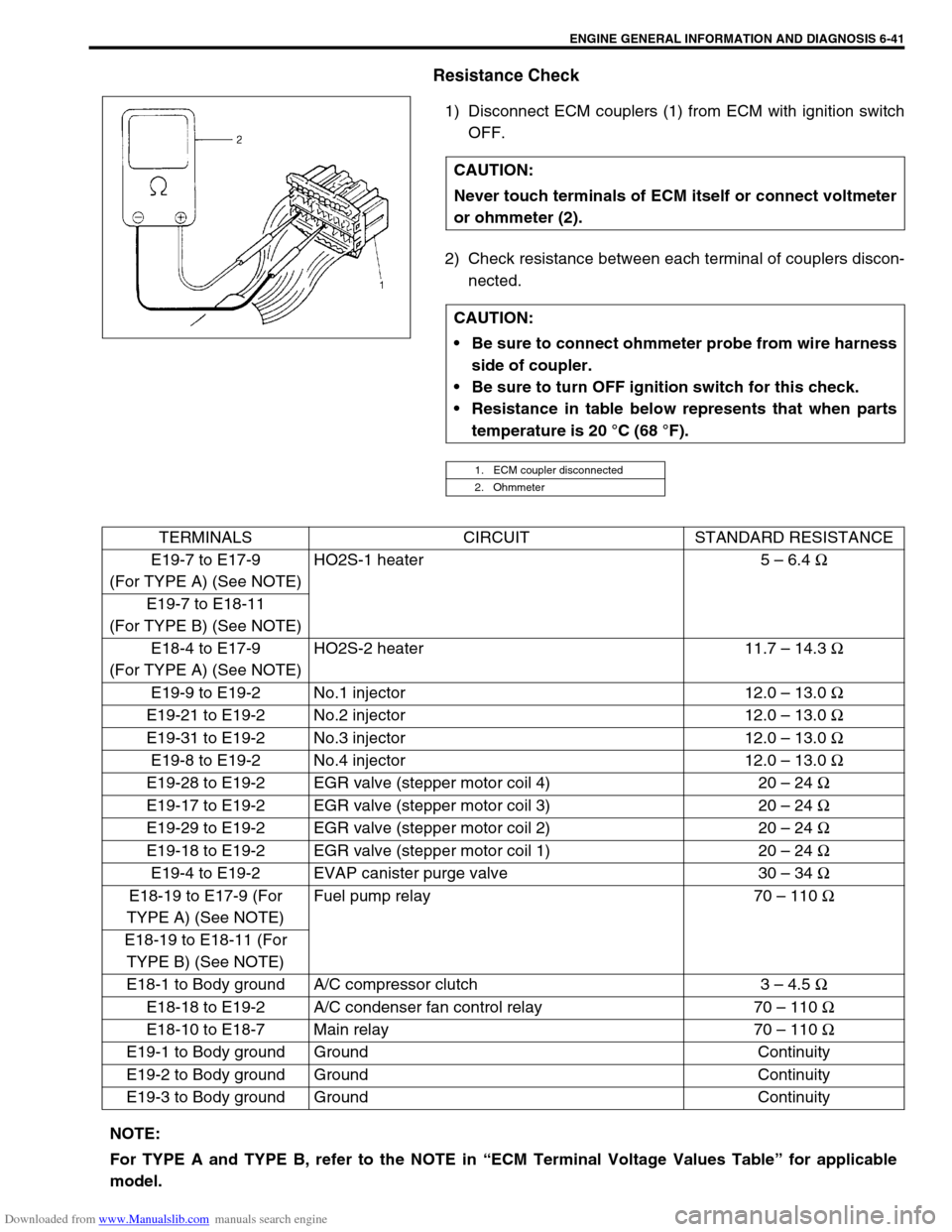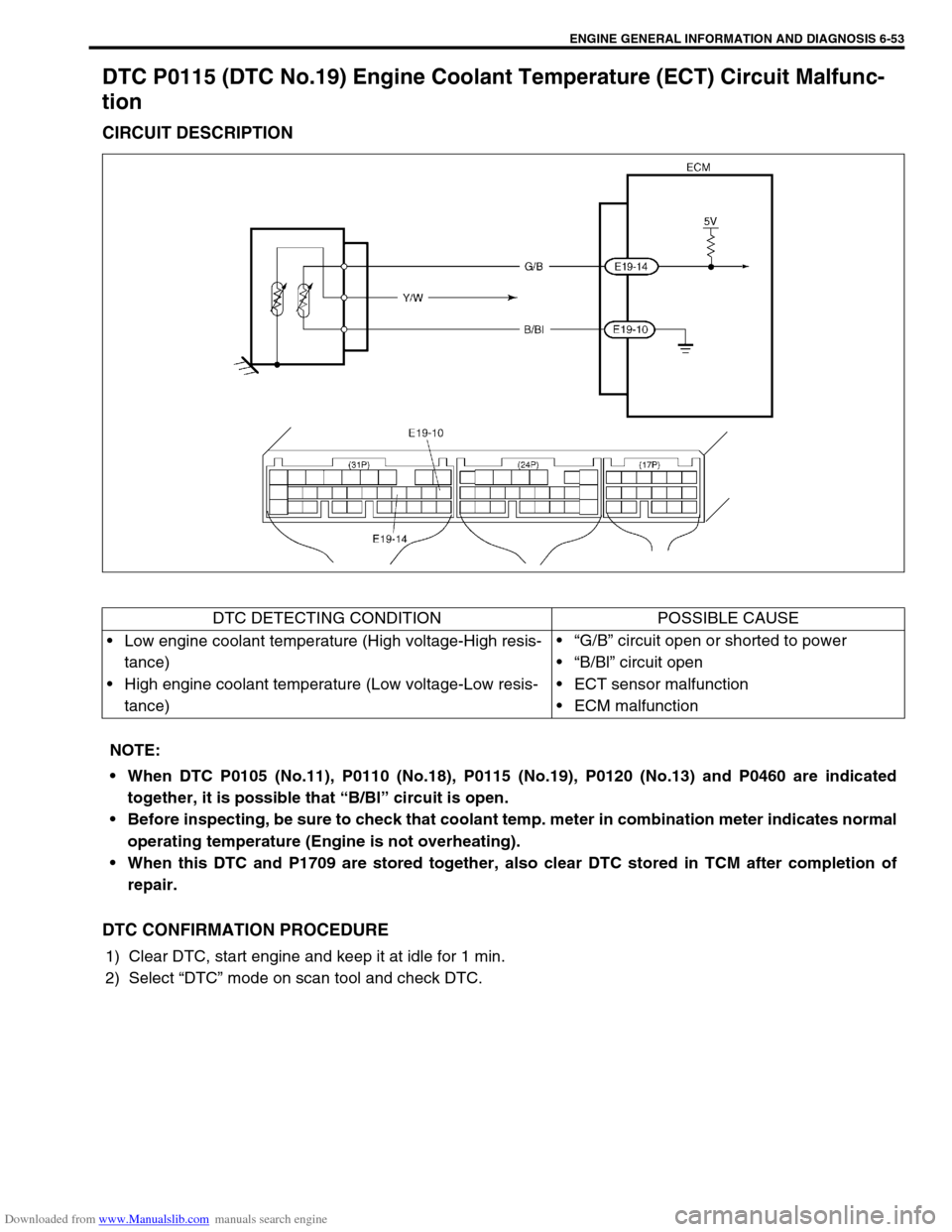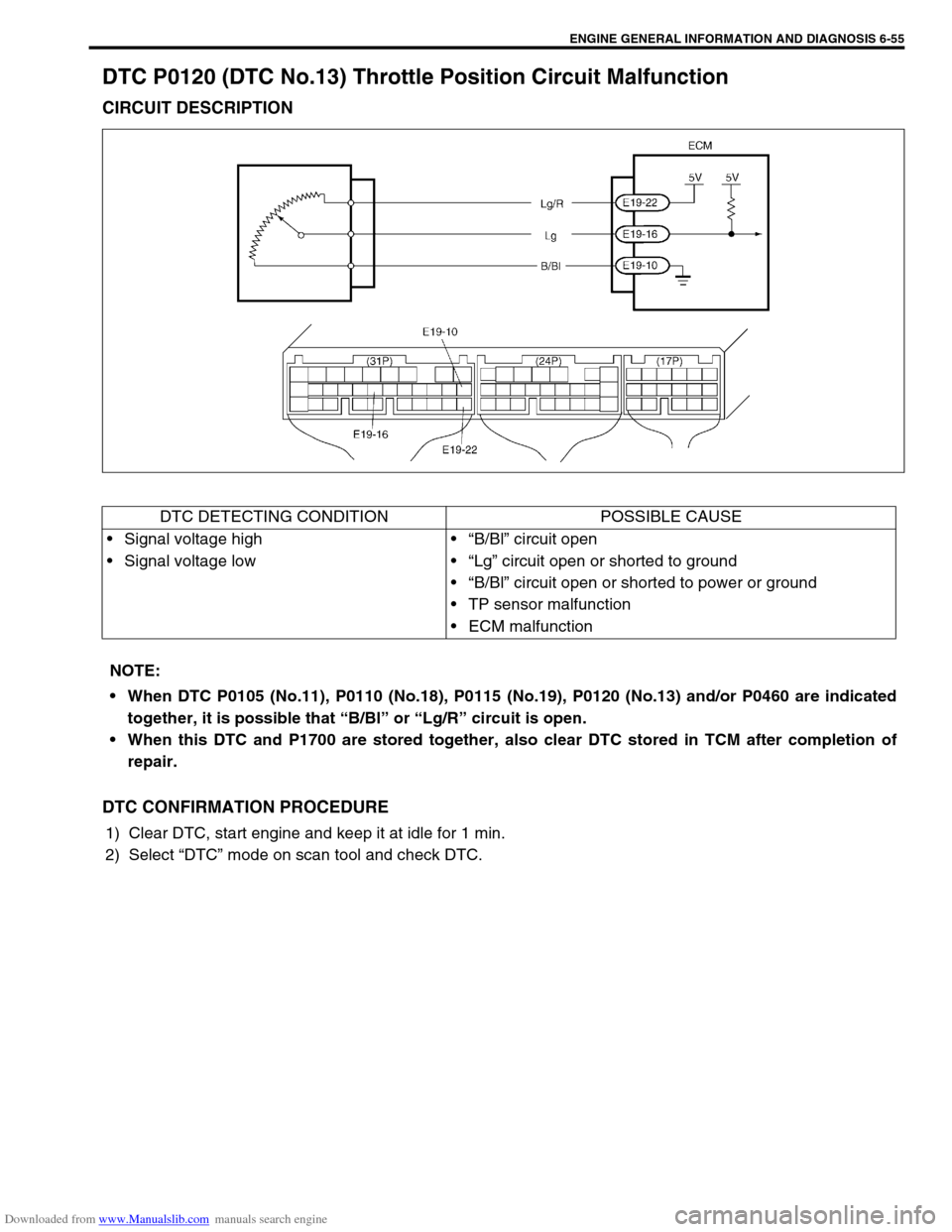ATE SUZUKI JIMNY 2005 3.G Service Workshop Manual
[x] Cancel search | Manufacturer: SUZUKI, Model Year: 2005, Model line: JIMNY, Model: SUZUKI JIMNY 2005 3.GPages: 687, PDF Size: 13.38 MB
Page 398 of 687

Downloaded from www.Manualslib.com manuals search engine ENGINE GENERAL INFORMATION AND DIAGNOSIS 6-41
Resistance Check
1) Disconnect ECM couplers (1) from ECM with ignition switch
OFF.
2) Check resistance between each terminal of couplers discon-
nected. CAUTION:
Never touch terminals of ECM itself or connect voltmeter
or ohmmeter (2).
CAUTION:
Be sure to connect ohmmeter probe from wire harness
side of coupler.
Be sure to turn OFF ignition switch for this check.
Resistance in table below represents that when parts
temperature is 20 °C (68 °F).
1. ECM coupler disconnected
2. Ohmmeter
TERMINALS CIRCUIT STANDARD RESISTANCE
E19-7 to E17-9
(For TYPE A) (See NOTE)HO2S-1 heater 5 – 6.4 Ω
E19-7 to E18-11
(For TYPE B) (See NOTE)
E18-4 to E17-9
(For TYPE A) (See NOTE)HO2S-2 heater 11.7 – 14.3 Ω
E19-9 to E19-2 No.1 injector 12.0 – 13.0 Ω
E19-21 to E19-2 No.2 injector 12.0 – 13.0 Ω
E19-31 to E19-2 No.3 injector 12.0 – 13.0 Ω
E19-8 to E19-2 No.4 injector 12.0 – 13.0 Ω
E19-28 to E19-2 EGR valve (stepper motor coil 4) 20 – 24 Ω
E19-17 to E19-2 EGR valve (stepper motor coil 3) 20 – 24 Ω
E19-29 to E19-2 EGR valve (stepper motor coil 2) 20 – 24 Ω
E19-18 to E19-2 EGR valve (stepper motor coil 1) 20 – 24 Ω
E19-4 to E19-2 EVAP canister purge valve 30 – 34 Ω
E18-19 to E17-9 (For
TYPE A) (See NOTE)Fuel pump relay 70 – 110 Ω
E18-19 to E18-11 (For
TYPE B) (See NOTE)
E18-1 to Body ground A/C compressor clutch 3 – 4.5 Ω
E18-18 to E19-2 A/C condenser fan control relay 70 – 110 Ω
E18-10 to E18-7 Main relay 70 – 110 Ω
E19-1 to Body ground Ground Continuity
E19-2 to Body ground Ground Continuity
E19-3 to Body ground Ground Continuity
NOTE:
For TYPE A and TYPE B, refer to the NOTE in “ECM Terminal Voltage Values Table” for applicable
model.
Page 402 of 687

Downloaded from www.Manualslib.com manuals search engine ENGINE GENERAL INFORMATION AND DIAGNOSIS 6-45
Table A-3 Malfunction Indicator Lamp Circuit Check - Mil Flashes at Ignition
Switch ON
WIRING DIAGRAM / CIRCUIT DESCRIPTION
Refer to table A-1.
INSPECTION
Table A-4 Malfunction Indicator Lamp Circuit Check - MIL Does Not Flash, Just
Remains ON or Just Remains OFF Even with Grounding Diagnosis Switch
Terminal
WIRING DIAGRAM / CIRCUIT DESCRIPTION
Refer to table A-1.
INSPECTION
Step Action Yes No
1 MIL flashing pattern check :
1) With the ignition switch ON position, check
MIL flashing pattern.
Does MIL flashing pattern indicate DTC (diag-
nostic trouble code)?Go to Step 2. Go to “Diagnosis” in Sec-
tion 8G.
2 Diagnosis switch terminal check :
1) With the ignition switch ON position, check
voltage between E18-14 terminal of ECM
coupler and ground.
Is voltage 4 – 5 V?Substitute a known-good
ECM and recheck.“W/Bl” wire (diagnosis
switch terminal) shorted
to ground circuit.
If OK, substitute a known-
good ECM and recheck.
Step Action Yes No
1 MIL flashing pattern check :
1) With grounding diagnosis switch terminal
and turn the ignition switch ON position,
check voltage between E18-14 terminal of
ECM connector and ground.
Is voltage 0 – 1 V?Go to Step 2.“W/Bl” wire (diagnosis
switch terminal), “B” wire
of monitor connector
open.
If OK, substitute a known-
good ECM and recheck.
2 Test switch terminal circuit check :
1) With the ignition switch ON position, check
voltage between E18-15 terminal of ECM
connector and ground.
Is voltage 4 – 5 V?Substitute a known-good
ECM and recheck.“P” wire (test switch termi-
nal) shorted to ground cir-
cuit.
If OK, substitute a known-
good ECM and recheck.
Page 405 of 687

Downloaded from www.Manualslib.com manuals search engine 6-48 ENGINE GENERAL INFORMATION AND DIAGNOSIS
DTC P0105 (DTC No.11) Manifold Absolute Pressure (MAP) Circuit Malfunc-
tion
CIRCUIT DESCRIPTION
DTC CONFIRMATION PROCEDURE
1) Clear DTC, start engine and keep it at idle for 1 min.
2) Select “DTC” mode on scan tool and check DTC.
INSPECTION
DTC DETECTING CONDITION POSSIBLE CAUSE
MAP sensor signal is 0.19 V or lower.
(Low pressure – High vacuums – Low voltage)
MAP sensor signal is 4.5 V or higher.
(High pressure – Low vacuums – High voltage)“B/Bl” circuit open
“Lg/R” circuit open or shorted to ground
“G” circuit open or shorted to ground
MAP sensor malfunction
ECM malfunction
NOTE:
When DTC P0120 is indicated together, it is possible that “Lg/R” circuit is open.
When DTC P0105 (No.11), P0110 (No.18) P0115 (No.19) P0120 (No.13) and P0460 are indicated
together, it is possible that “B/Bl” circuit is open.
Step Action Yes No
1Was “Engine Diag. Flow Table” performed? Go to Step 2. Go to “Engine Diag. Flow
Table”.
2 Check MAP Sensor and Its Circuit.
1) Connect scan tool to DLC with ignition
switch OFF. See Fig. 1.
2) Turn ignition switch ON.
3) Check intake manifold pressure.
Is it 126 kPa (37.2 inHg) or 0 kPa (0 inHg)?Go to Step 3. Intermittent trouble.
Check for intermittent
referring to “Intermittent
and Poor Connection” in
Section 0A.
Page 408 of 687

Downloaded from www.Manualslib.com manuals search engine ENGINE GENERAL INFORMATION AND DIAGNOSIS 6-51
DTC P0110 (DTC No.18) Intake Air Temp. (IAT) Circuit Malfunction
CIRCUIT DESCRIPTION
DTC CONFIRMATION PROCEDURE
1) Clear DTC, start engine and keep it at idle for 1 min.
2) Select “DTC” mode no scan tool and check DTC.
INSPECTION
DTC DETECTING CONDITION POSSIBLE CAUSE
Low intake air temperature (High voltage-High resistance)
High intake air temperature (Low voltage-Low resistance)“Lg/R” circuit open or shorted to power.
“B/Bl” circuit open
IAT sensor malfunction
ECM malfunction
NOTE:
When DTC P0105 (No.11), P0110 (No.18), P046, P0115 (No.19) and P0120 (No.13) are indicated
together, it is possible that “B/Bl” circuit is open.
Before inspecting, be sure to check that ambient temperature is higher than –40 °C (–40 °F).
Step Action Yes No
1Was “Engine Diag. Flow Table” performed? Go to Step 2. Go to “Engine Diag. Flow
Table”.
2 Check IAT Sensor and Its Circuit.
1) Connect scan tool to DLC with ignition
switch OFF. See Fig. 1.
2) Turn ignition switch ON.
3) Check intake air temp. displayed on scan
tool.
Is –40 °C (–40 °F) or 119 °C (246 °F) indicated?Go to Step 3. Intermittent trouble.
Check for intermittent
referring to “Intermittent
and Poor Connection” in
Section 0A.
Page 409 of 687
![SUZUKI JIMNY 2005 3.G Service Workshop Manual Downloaded from www.Manualslib.com manuals search engine 6-52 ENGINE GENERAL INFORMATION AND DIAGNOSIS
[A] Fig. 1 for Step 2 / [B] Fig. 2 for Step 3 / [C] Fig. 3 for Step 63 Check Wire Harness.
1) Dis SUZUKI JIMNY 2005 3.G Service Workshop Manual Downloaded from www.Manualslib.com manuals search engine 6-52 ENGINE GENERAL INFORMATION AND DIAGNOSIS
[A] Fig. 1 for Step 2 / [B] Fig. 2 for Step 3 / [C] Fig. 3 for Step 63 Check Wire Harness.
1) Dis](/img/20/7588/w960_7588-408.png)
Downloaded from www.Manualslib.com manuals search engine 6-52 ENGINE GENERAL INFORMATION AND DIAGNOSIS
[A] Fig. 1 for Step 2 / [B] Fig. 2 for Step 3 / [C] Fig. 3 for Step 63 Check Wire Harness.
1) Disconnect IAT sensor connector with igni-
tion switch OFF.
2) Check for proper connection to IAT sensor
at “Lg/B” and “B/Bl” wire terminals.
See Fig. 2.
3) If OK, then with ignition switch ON.
Is voltage applied to “Lg/B” wire terminal about
4 – 6 V?Go to Step 5.“Lg/B” wire open or
shorted to power, or poor
E19-15 connection.
If wire and connection are
OK, substitute a known-
good ECM and recheck.
4 Does scan tool indicate –40 °C (–40 °F) at Step
2.Go to Step 6. Go to Step 5.
5 Check Wire Harness
1) Check intake air temp. displayed on scan
tool with ignition switch ON.
Is –40 °C (–40 °F) indicated?Replace IAT sensor.“Lg/B” wire shorted to
ground.
If wire is OK, substitute a
known-good ECM and
recheck.
6 Check Wire Harness.
1) Using service wire, connect IAT sensor con-
nector terminals.
2) Check intake air temp. displayed on scan
tool with ignition switch ON. See Fig. 3.
Is 119 °C (246 °F) indicated?Replace IAT sensor.“Lg/B” wire open or poor
E19-10 connection.
If wire and connection are
OK, substitute a known-
good ECM and recheck. Step Action Yes No
Page 410 of 687

Downloaded from www.Manualslib.com manuals search engine ENGINE GENERAL INFORMATION AND DIAGNOSIS 6-53
DTC P0115 (DTC No.19) Engine Coolant Temperature (ECT) Circuit Malfunc-
tion
CIRCUIT DESCRIPTION
DTC CONFIRMATION PROCEDURE
1) Clear DTC, start engine and keep it at idle for 1 min.
2) Select “DTC” mode on scan tool and check DTC.
DTC DETECTING CONDITION POSSIBLE CAUSE
Low engine coolant temperature (High voltage-High resis-
tance)
High engine coolant temperature (Low voltage-Low resis-
tance)“G/B” circuit open or shorted to power
“B/Bl” circuit open
ECT sensor malfunction
ECM malfunction
NOTE:
When DTC P0105 (No.11), P0110 (No.18), P0115 (No.19), P0120 (No.13) and P0460 are indicated
together, it is possible that “B/Bl” circuit is open.
Before inspecting, be sure to check that coolant temp. meter in combination meter indicates normal
operating temperature (Engine is not overheating).
When this DTC and P1709 are stored together, also clear DTC stored in TCM after completion of
repair.
Page 411 of 687
![SUZUKI JIMNY 2005 3.G Service Workshop Manual Downloaded from www.Manualslib.com manuals search engine 6-54 ENGINE GENERAL INFORMATION AND DIAGNOSIS
INSPECTION
[A] Fig. 1 for Step 2 / [B] Fig. 2 for Step 5 / [C] Fig. 3 for Step 6Step Action Yes N SUZUKI JIMNY 2005 3.G Service Workshop Manual Downloaded from www.Manualslib.com manuals search engine 6-54 ENGINE GENERAL INFORMATION AND DIAGNOSIS
INSPECTION
[A] Fig. 1 for Step 2 / [B] Fig. 2 for Step 5 / [C] Fig. 3 for Step 6Step Action Yes N](/img/20/7588/w960_7588-410.png)
Downloaded from www.Manualslib.com manuals search engine 6-54 ENGINE GENERAL INFORMATION AND DIAGNOSIS
INSPECTION
[A] Fig. 1 for Step 2 / [B] Fig. 2 for Step 5 / [C] Fig. 3 for Step 6Step Action Yes No
1Was “Engine Diag. Flow Table” performed? Go to Step 2. Go to “Engine Diag. Flow
Table”.
2 Check ECT Sensor and Its Circuit.
1) Connect scan tool with ignition switch OFF.
See Fig. 1.
2) Turn ignition switch ON.
3) Check engine coolant temp. displayed on
scan tool.
Is –40 °C (–40 °F) or 119 °C (246 °F) indicated?Go to Step 3. Intermittent trouble.
Check for intermittent
referring to “Intermittent
and Poor Connection” in
Section 0A.
3 Check Wire Harness.
1) Disconnect ECT sensor connector.
2) Check engine coolant temp. displayed on
scan tool.
Is –40 °C (–40 °F) indicated?Replace ECT sensor.“G/B” wire shorted to
ground.
If wire is OK, substitute a
known-good ECM and
recheck.
4 Does scan tool indicate –40 °C (–40 °F) at Step
2.Go to Step 6. Go to Step 5.
5 Check Wire Harness.
1) Disconnect ECT sensor connector with igni-
tion switch OFF.
2) Check for proper connection to ECT sensor
at “B/Bl” and “G/B” wire terminals.
See Fig. 2.
3) If OK, then with ignition switch ON.
Is voltage applied to “B/Bl” wire terminal about
4 – 6 V?Go to Step 4.“G/B” wire open or
shorted to power, or poor
E19-14 connection.
If wire and connection are
OK, substitute a known-
good ECM and recheck.
6 Check Wire Harness.
1) Using service wire, connect ECT sensor
connector terminals. See Fig. 3.
2) Turn ignition switch ON and check engine
coolant temp. displayed on scan tool.
Is 119 °C (246 °F) indicated?Replace ECT sensor.“B/Bl” wire open or poor
E19-10 connection.
If wire and connection are
OK, substitute a known-
good ECM and recheck.
Page 412 of 687

Downloaded from www.Manualslib.com manuals search engine ENGINE GENERAL INFORMATION AND DIAGNOSIS 6-55
DTC P0120 (DTC No.13) Throttle Position Circuit Malfunction
CIRCUIT DESCRIPTION
DTC CONFIRMATION PROCEDURE
1) Clear DTC, start engine and keep it at idle for 1 min.
2) Select “DTC” mode on scan tool and check DTC. DTC DETECTING CONDITION POSSIBLE CAUSE
Signal voltage high
Signal voltage low“B/Bl” circuit open
“Lg” circuit open or shorted to ground
“B/Bl” circuit open or shorted to power or ground
TP sensor malfunction
ECM malfunction
NOTE:
When DTC P0105 (No.11), P0110 (No.18), P0115 (No.19), P0120 (No.13) and/or P0460 are indicated
together, it is possible that “B/Bl” or “Lg/R” circuit is open.
When this DTC and P1700 are stored together, also clear DTC stored in TCM after completion of
repair.
Page 414 of 687

Downloaded from www.Manualslib.com manuals search engine ENGINE GENERAL INFORMATION AND DIAGNOSIS 6-57
DTC P0121 Throttle Position Circuit Range / Performance Problem
WIRING DIAGRAM
Refer to DTC P0120 section.
CIRCUIT DESCRIPTION
DTC CONFIRMATION PROCEDURE
1) Turn ignition switch OFF. Clear DTC with ignition switch ON, check vehicle and environmental condition for :
–Altitude (barometric pressure) : 2400 m, 8000 ft or less (560 mmHg, 75 kPa or more)
–Ambient temp. : –10 °C, 14 °F or higher
–Intake air temp. : 70 °C, 158 °F or lower
–Engine coolant temp. : 70 °C, 158 °F or higher
2) Warm up engine to normal operating temperature.
3) Increase vehicle speed to 30 – 40 mph, 50 – 60 km/h in 3rd gear or “D” range and hold throttle valve at that
opening position for 1 min.
4) Stop vehicle.
5) Check DTC in “DTC” mode and pending DTC in “ON BOARD TEST” or “PENDING DTC” mode.
INSPECTION
DTC DETECTING CONDITION POSSIBLE CAUSE
After engine warmed up.
Difference between actual throttle opening (detected from TP sensor)
and opening calculated by ECM (Obtained on the basis of engine
speed and intake manifold pressure) in larger than specified value.
✱2 driving cycle detection logic, continuous monitoringTP sensor malfunction
High resistance in the circuit
ECM malfunction
WARNING:
When performing a road test, select a place where there is no traffic or possibility of a traffic acci-
dent and be very careful during testing to avoid occurrence of an accident.
Road test should be carried out with 2 persons, a driver and a tester, on a level road.
Step Action Yes No
1Was “Engine Diag. Flow Table” performed? Go to Step 2. Go to “Engine Diag. Flow
Table”.
2 Is SUZUKI scan tool available? Go to Step 3. Go to Step 4.
3 Check TP Sensor and Its Circuit.
1) Turn ignition switch OFF and connect
SUZUKI scan tool to DLC. See Fig. 1.
2) Turn ignition switch ON and check TP sen-
sor output voltage when throttle valve is at
idle position and fully opened. See Fig. 3.
Dose voltage vary within specified value linearly
as shown in figure?Substitute a known-good
ECM and recheck.Go to Step 5.
Page 416 of 687

Downloaded from www.Manualslib.com manuals search engine ENGINE GENERAL INFORMATION AND DIAGNOSIS 6-59
DTC P0130 (DTC No.14) Heated Oxygen Sensor (HO2S) Circuit Malfunction
(Sensor-1)
CIRCUIT DESCRIPTION
DTC CONFIRMATION PROCEDURE
1) Turn ignition switch OFF. Clear DTC with ignition switch ON, check vehicle and environmental condition for :
–Altitude (barometric pressure) : 2400 m, 8000 ft or less (560 mmHg, 75 kPa or more)
–Ambient temp. : –10 °C, 14 °F or higher
–Intake air temp. : 70 °C, 158 °F or lower
2) Warm up engine to normal operating temperature.
3) Drive vehicle at 30 – 40 mph, 50 – 60 km/h for 2 min.
4) Stop vehicle and run engine at idle for 2 min.
5) Check DTC in “DTC” mode and pending DTC in “ON BOARD TEST” or “PENDING DTC” mode.
1. Heated oxygen sensor-1 (HO2S-1)
DTC DETECTING CONDITION POSSIBLE CAUSE
When running at idle speed after engine warmed up and
running at specified vehicle speed, HO2S-1 output volt-
age does not go below 0.3 V or over 0.6 V.
✱2 driving cycle detection logic, Monitoring once / 1 driving.Heated oxygen sensor-1 malfunction
“B/Bl” or “R” circuit open (poor connection) or
short
WARNING:
When performing a road test, select a place where there is no traffic or possibility of a traffic acci-
dent and be very careful during testing to avoid occurrence of an accident.
Road test should be carried out with 2 persons, a driver and a tester.